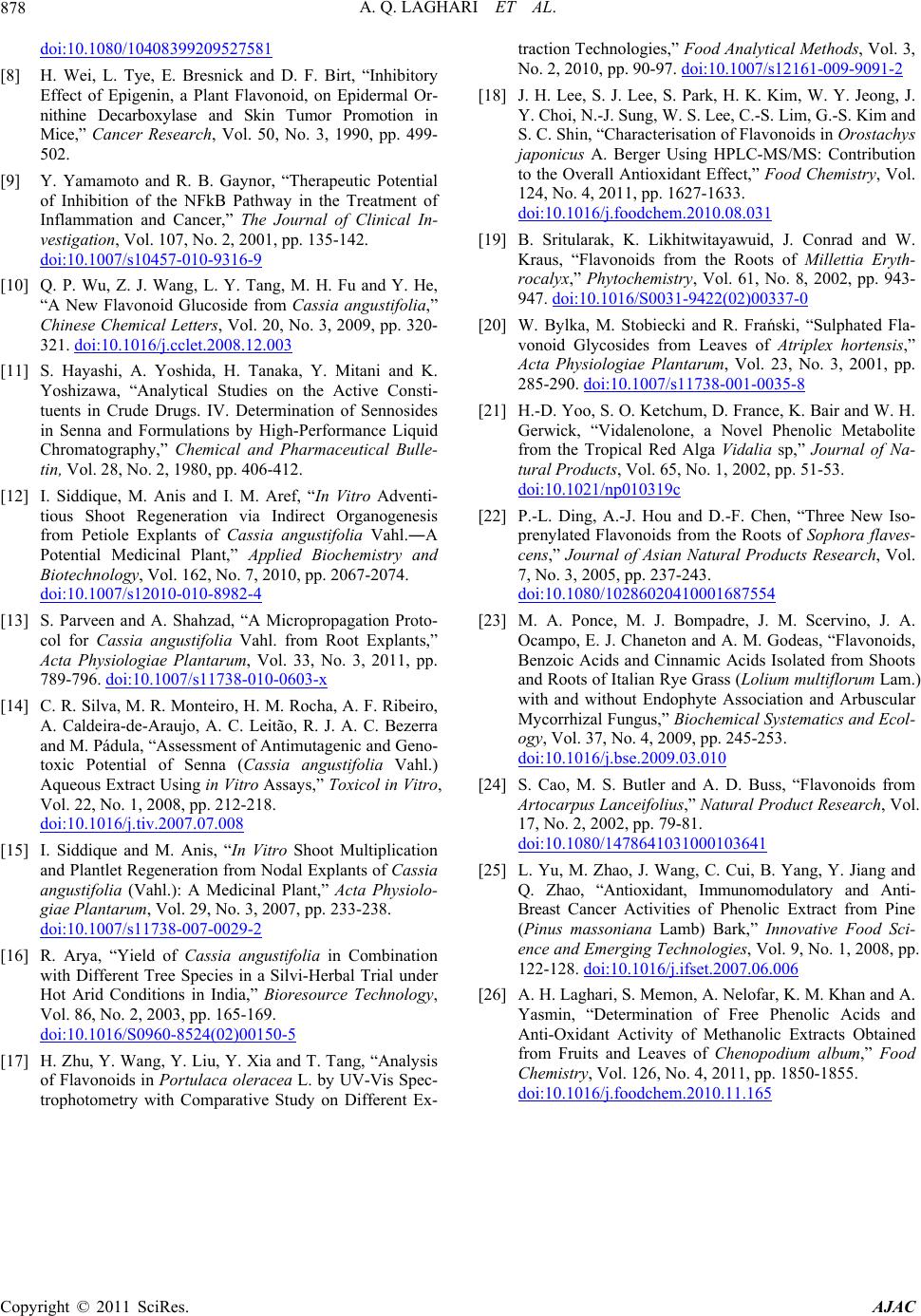
A. Q. LAGHARI ET AL.
878
doi:10.1080/10408399209527581
[8] H. Wei, L. Tye, E. Bresnick and D. F. Birt, “Inhibitory
Effect of Epigenin, a Plant Flavon
nithine Decarboxylase and Skin
oid, on Epidermal Or-
Tumor Promotion in
mation and Cancer,” The Journal of Clinical In-
Mice,” Cancer Research, Vol. 50, No. 3, 1990, pp. 499-
502.
[9] Y. Yamamoto and R. B. Gaynor, “Therapeutic Potential
of Inhibition of the NFkB Pathway in the Treatment of
Inflam
vestigation, Vol. 107, No. 2, 2001, pp. 135-142.
doi:10.1007/s10457-010-9316-9
[10] Q. P. Wu, Z. J. Wang, L. Y. Tang, M. H. Fu and Y. He,
“A New Flavonoid Glucoside from Cassia angus
Chinese Chemical Letters, Vol. 2
tifolia,”
0, No. 3, 2009, pp. 320-
321. doi:10.1016/j.cclet.2008.12.003
[11] S. Hayashi, A. Yoshida, H. Tanaka, Y. Mitani and K.
Yoshizawa, “Analytical Studies on the Active Consti-
tuents in Crude Drugs. IV. Determination of Sennosides
stifolia Vahl.
in Senna and Formulations by High-Performance Liquid
Chromatography,” Chemical and Pharmaceutical Bulle-
tin, Vol. 28, No. 2, 1980, pp. 406-412.
[12] I. Siddique, M. Anis and I. M. Aref, “In Vitro Adventi-
tious Shoot Regeneration via Indirect Organogenesis
from Petiole Explants of Cassia angu―A
Potential Medicinal Plant,” Applied Biochemistry and
Biotechnology, Vol. 162, No. 7, 2010, pp. 2067-2074.
doi:10.1007/s12010-010-8982-4
[13] S. Parveen and A. Shahzad, “A Micropropagation Proto-
col for Cassia angustifolia Vahl. from Root Explants
Acta Physiologiae Plantarum, V
,”
ol. 33, No. 3, 2011, pp.
789-796. doi:10.1007/s11738-010-0603-x
[14] C. R. Silva, M. R. Monteiro, H. M. Rocha, A. F. Ribeiro,
A. Caldeira-de-Araujo, A. C. Leitão, R. J. A. C. Bezerra
and M. Pádula, “Assessment of Antimutagenic and Geno-
toxic Potential of Senna (Cassia angustifolia Vahl.)
Aqueous Extract Using in Vitro Assays,” Toxicol in Vitro,
Vol. 22, No. 1, 2008, pp. 212-218.
doi:10.1016/j.tiv.2007.07.008
[15] I. Siddique and M. Anis, “In Vitro Shoot Multiplication
and Plantlet Regeneration from Nod
angustifolia (Vahl.): A Medici
al Explants of Cassia
nal Plant,” Acta Physiolo-
giae Plantarum, Vol. 29, No. 3, 2007, pp. 233-238.
doi:10.1007/s11738-007-0029-2
[16] R. Arya, “Yield of Cassia angustifolia in Combination
with Different Tree Species in a Silvi-Herbal Trial u
Hot Arid Conditions in India,” Bioresource Technology
nder
,
Vol. 86, No. 2, 2003, pp. 165-169.
doi:10.1016/S0960-8524(02)00150-5
[17] H. Zhu, Y. Wang, Y. Liu, Y. Xia and T. Tang, “Analysis
of Flavonoids in Portulaca oleracea L
trophotometry with Comparative Stud
. by UV-Vis Spec-
y on Different Ex-
traction Technologies,” Food Analytical Methods, Vol. 3,
No. 2, 2010, pp. 90-97. doi:10.1007/s12161-009-9091-2
[18] J. H. Lee, S. J. Lee, S. Park, H. K. Kim, W. Y. Jeong, J.
1
Y. Choi, N.-J. Sung, W. S. Lee, C.-S. Lim, G.-S. Kim and
S. C. Shin, “Characterisation of Flavonoids in Orostachys
japonicus A. Berger Using HPLC-MS/MS: Contribution
to the Overall Antioxidant Effect,” Food Chemistry, Vol.
124, No. 4, 2011, pp. 1627-1633.
doi:10.1016/j.foodchem.2010.08.03
J. Conrad and W. [19] B. Sritularak, K. Likhitwitayawuid,
Kraus, “Flavonoids from the Roots of Millettia Eryth-
rocalyx,” Phytochemistry, Vol. 61, No. 8, 2002, pp. 943-
947. doi:10.1016/S0031-9422(02)00337-0
[20] W. Bylka, M. Stobiecki and R. Frański, “Sulphated Fla-
vonoid Glycosides from Leaves of Atriplex hortensis,”
Acta Physiologiae Plantarum, Vol. 23, No. 3, 2001, pp.
285-290. doi:10.1007/s11738-001-0035-8
[21] H.-D. Yoo, S. O. Ketchum, D. France, K. Bair and W. H.
Gerwick, “Vidalenolone, a Novel Phenolic Metabolite
from the Tropical Red Alga Vidalia sp,” Journal of Na-
tural Products, Vol. 65, No. 1, 2002, pp. 51-53.
doi:10.1021/np010319c
[22] P.-L. Ding, A.-J. Hou and D.-F. Chen, “Three New Iso-
87554
prenylated Flavonoids from the Roots of Sophora flaves-
cens,” Journal of Asian Natural Products Research, Vol.
7, No. 3, 2005, pp. 237-243.
doi:10.1080/102860204100016
. Scervino, J. A. [23] M. A. Ponce, M. J. Bompadre, J. M
Ocampo, E. J. Chaneton and A. M. Godeas, “Flavonoids,
Benzoic Acids and Cinnamic Acids Isolated from Shoots
and Roots of Italian Rye Grass (Lolium multiflorum Lam.)
with and without Endophyte Association and Arbuscular
Mycorrhizal Fungus,” Biochemical Systematics and Ecol-
ogy, Vol. 37, No. 4, 2009, pp. 245-253.
doi:10.1016/j.bse.2009.03.010
[24] S. Cao, M. S. Butler and A. D. Buss, “Flavonoids from
03641
Artocarpus Lanceifolius,” Natural Product Research, Vol.
17, No. 2, 2002, pp. 79-81.
doi:10.1080/14786410310001
Yang, Y. Jiang and
[25] L. Yu, M. Zhao, J. Wang, C. Cui, B.
Q. Zhao, “Antioxidant, Immunomodulatory and Anti-
Breast Cancer Activities of Phenolic Extract from Pine
(Pinus massoniana Lamb) Bark,” Innovative Food Sci-
ence and Emerging Technologies, Vol. 9, No. 1, 2008, pp.
122-128. doi:10.1016/j.ifset.2007.06.006
[26] A. H. Laghari, S. Memon, A. Nelofar, K. M. Khan and A.
Yasmin, “Determination of Free Phenolic Acids and
Anti-Oxidant Activity of Methanolic Extracts Obtained
from Fruits and Leaves of Chenopodium album,” Food
Chemistry, Vol. 126, No. 4, 2011, pp. 1850-1855.
doi:10.1016/j.foodchem.2010.11.165
Copyright © 2011 SciRes. AJAC